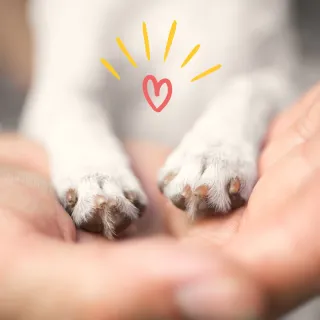How to Communicate With a Deaf Pet by Mikkel Becker
By Advisory Board Member Mikkel Becker, Reposted Courtesy of Vetstreet
One of the greatest challenges for an aging dog is hearing loss. Just because your pet may be losing his hearing, however, doesn’t mean he can’t continue to be a fully functioning member of your household. It simply takes a little creativity and training to bridge the communication gap.
Where to Start
If you notice hearing loss in your pet, the first place to go is to your veterinarian. Your dog’s change in hearing may simply be age-related, but there are a number of possible causes, including ear infections or a foreign body or growth in the ear, which need to be addressed by a veterinarian. Your veterinarian can rule out specific issues, and in some cases can treat, and even reverse, the loss.
However, your dog’s hearing loss may be permanent, and this will call for a change in the way you communicate with your four-legged companion.
Communicating With Your Pet
Giving your dog audible feedback becomes more difficult when your pet has hearing loss, since he won’t be easily able to hear a clicker or your voice. For this reason, you will need to teach your dog a signal, like a hand clap or a thumbs up that means “good dog” or “job well done.” Teach your pet to recognize the “good dog” signal by immediately following it with a reward such as a treat, for example, or another enjoyable activity like being petted, chasing a ball, playing tug or going outside.
It’s also essential that you have a signal to get your dog’s attention, which is called a “look at me” cue. This cue tells your dog to focus his attention in your direction so he can be led to do a behavior on a visual signal. A hearing-impaired dog needs to focus on his handler’s body to pick up signals for what he is being asked to do, whether it be a sit, a down, or a trick.
When you are walking your dog, a gentle, low pull, or a jingle on his leash can be a signal for him to reorient his body to face you. When off leash, a hand wave, a gentle touch on the shoulder or back, or a flashlight or other visual stimulus serves the same purpose. As with any signal, you must teach your pet what the signal means.
Change Your Cues
To teach your pet to look at you in response to the signal, initiate the stimulus, such as a light touch on his shoulder or a gentle pull on the leash, and move a treat out in front of his nose and up toward your eye level. As soon as your dog gives eye contact, mark with your “good dog” signal, such as a thumbs up, followed by a treat. Once your pet is readily giving you eye contact in response to the signal, begin to phase out the treat. Move your empty hand, still shaped like it has a treat inside it, up toward your eye level; reward your dog for making eye contact. Eventually, begin to fade out the hand signal by only moving your hand partially toward your face.
The goal is to get your pooch to make eye contact in response to the first cue, such as the shoulder touch or gentle leash pull, without any extra direction from you. Continue to highlight the wanted behavior with your “good dog” signal and a reward, or immediately ask your dog to do another behavior, such as a sit, when he looks at you. Commands your dog previously learned on a verbal signal will need to be retaught with a visual or physical cue. (Vetstreet has some helpful hints on how to transfer cues.)
Once your dog has learned to make eye contact with you, you can teach him other hand signals for everyday activities. Invent your own signals or use American Sign Language to teach your dog words like dinner, walk, car, bedtime and outside. Simply use the designated signal (such as the ASL sign for “walk”) and immediately follow it with the activity (head out the door for a walk with your dog). Be sure all members of your family are consistently using the same signals.
The more you use visual and physical signals with your pet, the better he will understand what you’re telling him. Changing the way your pet communicates will make his hearing loss easier on him — and on you.
By Advisory Board Member Mikkel Becker, Reposted Courtesy of Vetstreet



